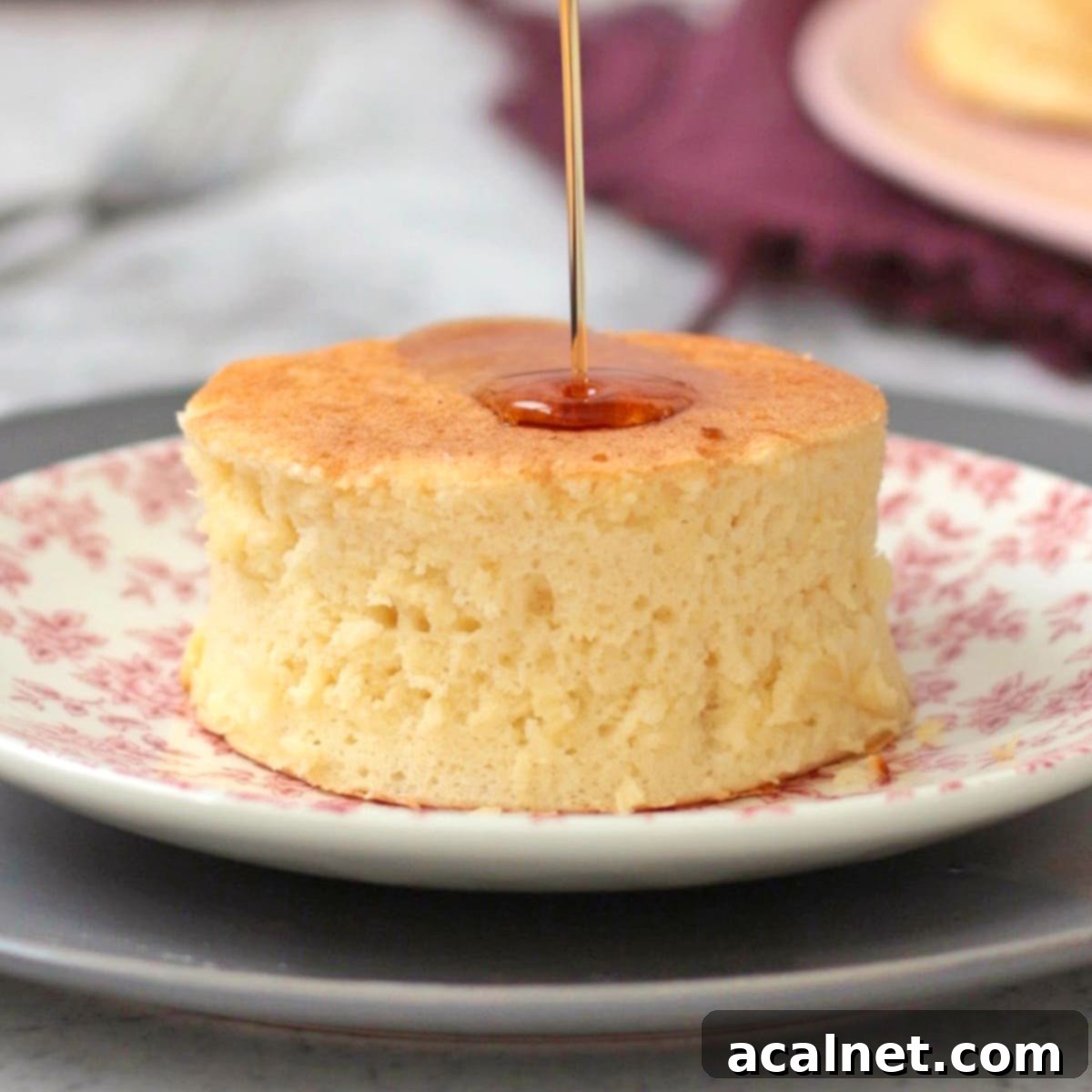Experience Heavenly Fluff: The Ultimate Japanese Soufflé Pancake Recipe
Prepare to embark on a culinary journey with this incredible FLUFFY PANCAKE recipe! Imagine biting into delicate, airy clouds – that’s precisely the experience these Japanese soufflé pancakes offer. Renowned for their extraordinary lightness and melt-in-your-mouth texture, they transform any ordinary meal into a special occasion. Perfect for an elegant brunch party or a delightful Sunday morning breakfast, these pancakes are a true showstopper that will captivate your taste buds and impress your guests. Get ready to discover your new favorite breakfast treat!

This article was first posted on Sunday Supper Movement where I am a contributor.
What Exactly Are Japanese Soufflé Pancakes?
Japanese Pancakes, widely celebrated as Japanese soufflé pancakes, represent a delightful and ethereal variation of the classic pancake we all know and love. While sharing a base of common ingredients with traditional American pancakes, their preparation method sets them miles apart, yielding a texture that is remarkably lighter, airier, and incomparably fluffy.
The magic behind these cloud-like creations lies in one crucial technique: the careful incorporation of stiffly whipped egg whites (meringue) into a rich egg yolk-based batter. This process infuses the batter with an abundance of air, which then expands during cooking, creating that signature towering, soufflé-like structure. Unlike regular pancakes, Japanese soufflé pancakes don’t rely solely on baking powder for their rise; the whipped egg whites are the true heroes, providing an unparalleled lightness that makes them literally melt in your mouth.
To achieve their iconic height and perfectly round, uniform shape, pastry rings or molds are typically used during the cooking process. These rings help contain the delicate batter as it rises, allowing the pancakes to steam gently and cook through while maintaining their impressive volume. The result is a breakfast or brunch item that not only tastes incredible but also looks absolutely stunning on a plate, resembling edible little clouds.
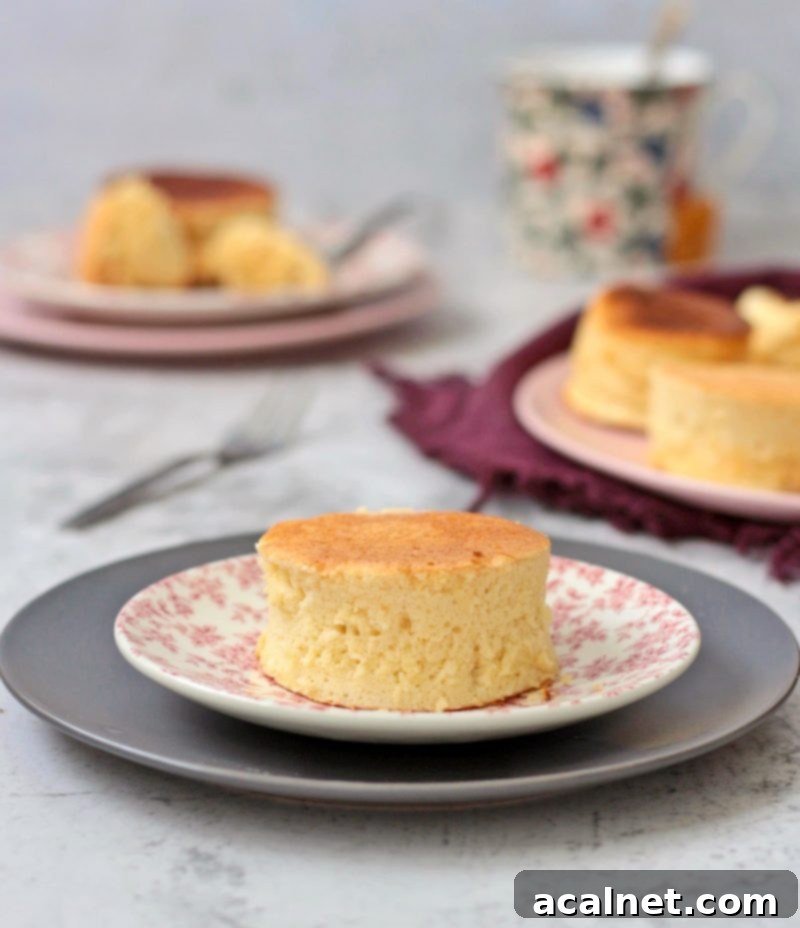
What Ingredients Do I Need for This Japanese Soufflé Pancake Recipe?
To craft these delightful Japanese soufflé pancakes, you’ll find that the ingredient list largely mirrors that of traditional American pancakes, with a focus on fresh components:
- Eggs – Specifically, you’ll need both egg yolks and egg whites, separated. The quality and freshness of your eggs are key here.
- Powdered Sugar – This finely milled sugar dissolves easily, contributing to a smooth batter and stable meringue.
- Whole Milk – Adds richness and moisture to the batter.
- Plain Flour / All-Purpose Flour – The structural base for our pancakes.
- Baking Powder – Provides a little extra lift and tenderizes the crumb.
- Salt – A pinch helps stabilize the egg whites and balances the sweetness.
Step-by-Step Guide: Crafting Your Fluffy Japanese Soufflé Pancakes
Creating these beautifully airy Japanese soufflé pancakes involves two main stages for the batter preparation, followed by a careful cooking process. Each step is crucial for achieving that signature fluffy texture and impressive height.
Phase 1: Preparing the Pancake Batter Base
First, we’ll create the foundational pancake batter using egg yolks, powdered sugar, milk, flour, and baking powder. This will be the rich, flavorful core of our soufflé pancakes.
- Begin by carefully separating the egg yolks from the egg whites. Place the egg yolks in a spacious mixing bowl. Reserve the egg whites in a separate, absolutely clean bowl, preferably the bowl of your stand mixer (an electric hand mixer works just as well). Ensure there is no trace of egg yolk in the egg whites, as this can prevent them from whipping properly.
- To the egg yolks, add the powdered sugar. Whisk vigorously until the mixture becomes pale in color and visibly airy, indicating that the sugar has dissolved and some air has been incorporated.
- Next, whisk in the whole milk (and vanilla extract if desired for an extra aromatic touch), then the all-purpose flour and baking powder until the batter is smooth and free of lumps. Set this delightful yellow batter aside.
Phase 2: Whipping the Egg Whites (Meringue)
This is where the magic happens! The stiffly whipped egg whites are what give Japanese soufflé pancakes their incredible lift and cloud-like consistency.
- Start whipping the reserved egg whites with a pinch of salt. Begin on a low speed to break up the whites, then gradually increase the speed of your mixer. Continue whipping until you achieve stiff peaks. This means that when you lift the whisk, the peaks of egg white stand straight up and hold their shape without drooping. Be careful not to over-beat, as this can make the meringue dry and difficult to fold.
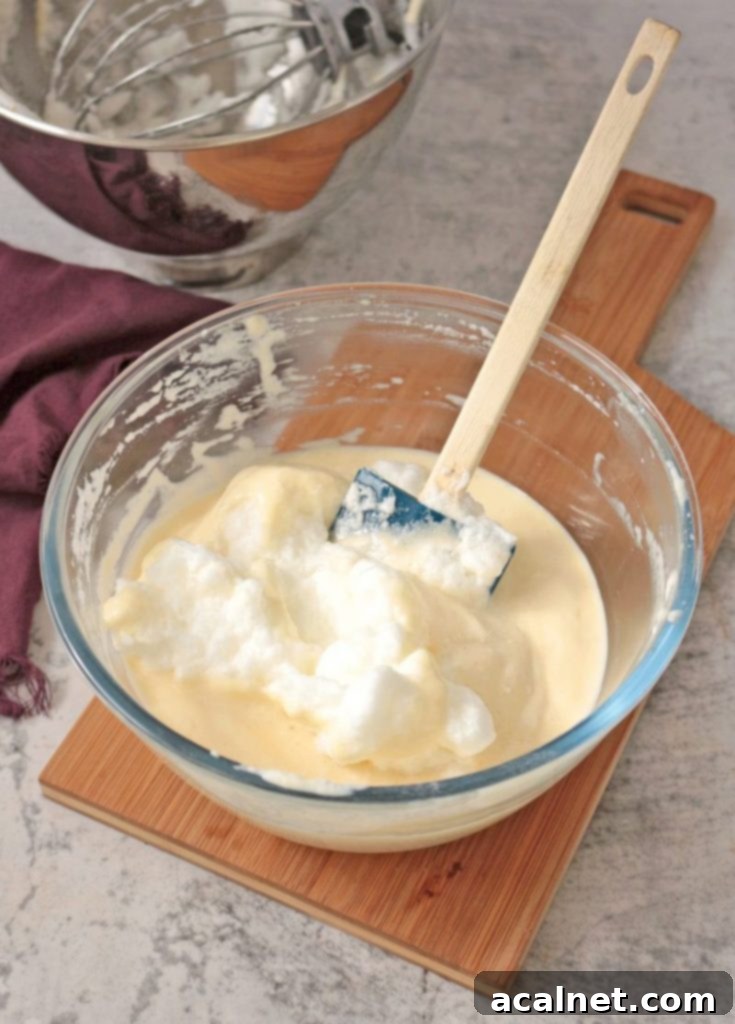
Phase 3: Gentle Folding and Preparing to Cook
Now that both components of your pancake batter are ready, it’s time to bring them together and prepare your cooking surface.
- Before combining, place your non-stick skillet (ideally one with a tight-fitting lid) on the lowest possible heat setting on your stove. This allows the pan to preheat very gently and evenly, crucial for the slow cooking of soufflé pancakes.
- While the pan warms up, it’s time to gently fold in the whipped egg whites into the egg yolk batter. Start by adding about one-third of the meringue to the yolk batter. Use a spatula to carefully fold it in until just combined. This lightens the yolk batter and makes it easier to incorporate the rest of the delicate meringue.
- Gradually add the remaining egg whites in two more additions, folding them in with a light hand. The key here is to preserve as much of the air in the egg whites as possible, so avoid over-mixing or beating the batter. The final soufflé pancake batter should be light, airy, and uniform in color, but still very fluffy.
At this stage, your skillet should be perfectly warm, and your magnificent Soufflé Pancake Batter is ready for cooking. The penultimate step is preparing your pastry rings to ensure flawless, tall pancakes.
Generously grease your pastry rings with cooking oil or butter (cooking oil spray often works best for easy release). This crucial step prevents the delicate pancakes from sticking and ensures they slide out effortlessly once cooked. If you don’t have pastry rings, don’t worry – refer to our section below for how to make these fluffy delights without molds!
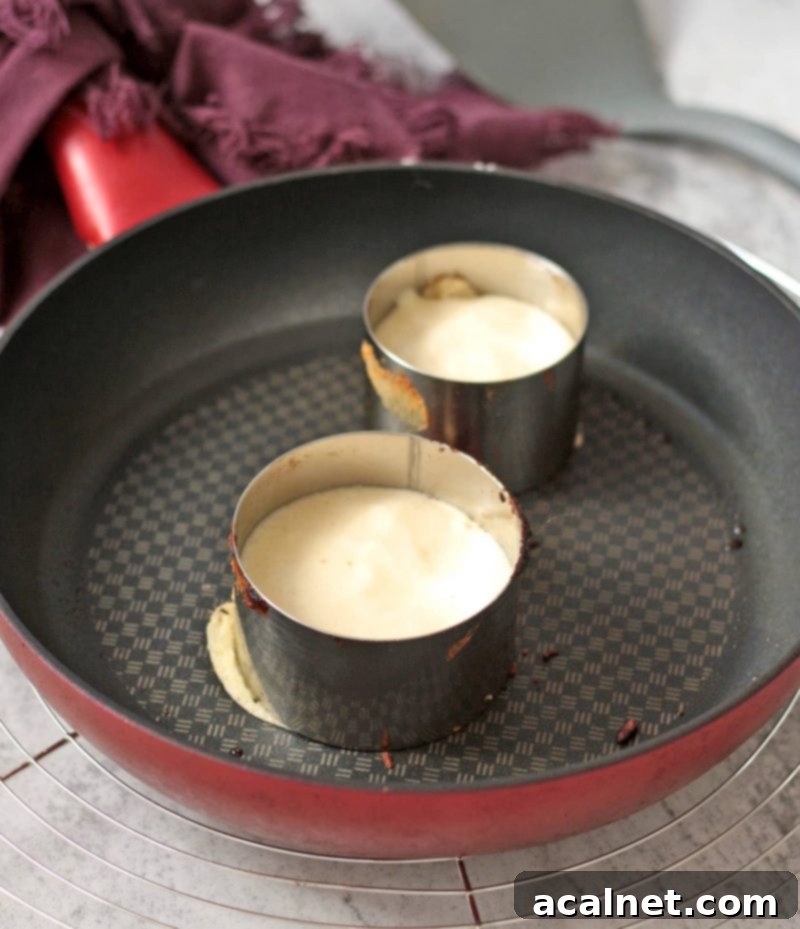
Cooking Your Soufflé Pancakes to Perfection
The moment has arrived! It’s time to cook your fluffy Japanese pancakes. Remember that gentle heat and a bit of patience are your best friends for achieving that perfect rise and golden-brown finish.
- Ensure the inside of your pastry rings are thoroughly greased, along with the surface of your already warm skillet. This dual greasing prevents sticking and ensures your pancakes release beautifully.
- Carefully place the greased pastry rings in the pan. Using a spoon or a small ladle, gently fill each ring with the delicate Japanese pancake batter. Only fill them to about half of the ring’s height, as these pancakes will puff up considerably during cooking. Overfilling can lead to uneven cooking or overflow.
- Promptly place the lid over the skillet, trapping the heat and steam, which helps the pancakes cook through and rise without drying out. Let them cook undisturbed for approximately 4 minutes.
- After 4 minutes, carefully lift the lid (watch out for steam!). Using a thin, flat spatula, gently flip the pancakes within their rings. This can be a delicate maneuver, so take your time. Replace the lid and continue cooking for another 3 minutes. This second cooking phase ensures both sides are lightly browned and the interior is fully cooked and fluffy.
- Once cooked, remove the pancakes from the skillet. Be extremely cautious, as the pastry rings will be very hot. Transfer the pancakes, still in their rings, to a cooling rack or directly onto your serving plates. If a pancake resists coming out of its ring, simply run a small, sharp knife around the inner edge of the ring to loosen it before gently pushing it out.
- Repeat this cooking process for any remaining batter, making sure to re-grease the rings and the skillet between each batch to maintain non-stick properties. Serve these delightful pancakes immediately while they are warm and at their fluffiest with your favorite toppings!
Do I Need Molds to Make Fluffy Japanese Pancakes?
While pastry rings undoubtedly help achieve that impressive height and perfectly round shape, the good news is, yes, you can make Japanese soufflé pancakes without using molds! The result might not be quite as tall or perfectly uniform, but the light, airy texture will still be there. To do this, you’ll need to adjust your cooking technique slightly:
- Layering the Batter: Using a spoon or a measuring cup, add a small amount of batter to your preheated, non-stick pan. We recommend cooking no more than two pancakes at a time in the same pan to allow for even cooking. Cover the pan with a lid and cook for approximately 4 minutes on the lowest heat possible. This slow cooking allows the first layer to set.
- Adding More Batter: After the initial 4 minutes, remove the lid and gently add another scoop (or a smaller amount) of pancake batter directly on top of each cooking pancake. This creates the layered effect that builds height. Cover the pan again and cook for another 4 minutes.
- Final Flip and Cook: Any remaining batter can be carefully added to the tops of the pancakes in small increments. Then, using a wide, thin spatula, gently flip the pancakes over. Cover the pan once more and cook for another 5 minutes or so, until the pancakes are fully cooked through and golden brown on both sides. The key is low heat and patience to ensure they cook without burning.
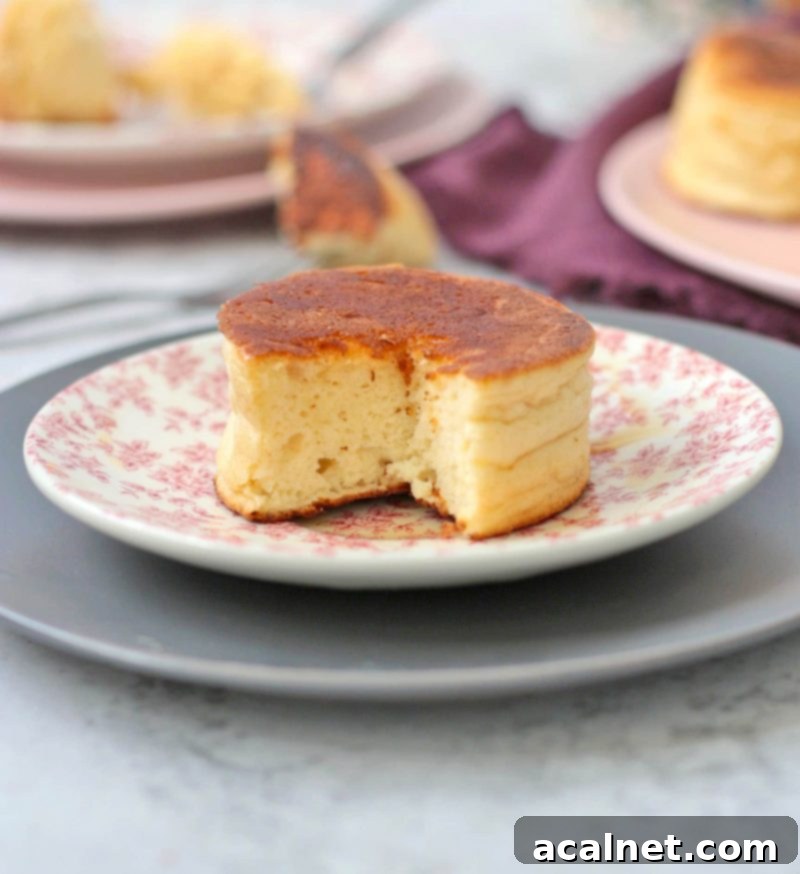
The Secret Behind the Soufflé: What Makes These Pancakes So Incredibly Fluffy?
While a modest amount of baking powder in this recipe does contribute to a slight lift, the true secret to the extraordinary fluffiness and remarkable height of Japanese soufflé pancakes lies almost entirely in the preparation and incorporation of stiffly beaten egg whites. This delicate meringue acts as a natural leavening agent, creating a light, airy structure that baking powder alone cannot replicate.
The process of whipping egg whites introduces countless tiny air bubbles into the mixture. When these are gently folded into the pancake batter and subsequently heated during cooking, the air expands, causing the pancakes to puff up dramatically, much like a classic soufflé. This critical step is often considered the most vital part of any fluffy pancake recipe, as the success of your pancakes hinges on achieving the perfect meringue consistency.
Essential Tips for Perfect Meringue:
To ensure your egg whites reach their full potential and create the lightest possible pancakes, keep these expert tips in mind:
- Ensure Your Equipment is Spotless: Any trace of grease or egg yolk in your mixing bowl or on your whisk can prevent the egg whites from whipping properly. Use a clean, dry metal or glass bowl (plastic bowls can sometimes retain grease).
- Room Temperature Egg Whites: While not strictly necessary, many chefs find that room temperature egg whites whip up faster and achieve greater volume than cold ones.
- Start Low, Go Slow: Begin whipping the egg whites on a slow speed to create small, uniform bubbles. Gradually increase the speed of your mixer to medium-high as the whites become foamy, and then to high as they thicken. This gradual approach creates a more stable meringue.
- The Role of Salt (or Cream of Tartar): Adding a small pinch of salt (or a tiny amount of cream of tartar, if preferred) helps to stabilize the egg whites, making them stronger and less likely to deflate.
- Achieve Stiff Peaks, But Don’t Over-Beat: Continue whipping until the egg whites form stiff peaks. This means when you lift the whisk, the peaks stand firm and straight. However, be vigilant and careful not to over-beat the egg whites. Over-beaten whites become dry, granular, and can separate, making them difficult to fold smoothly into the batter and potentially leading to dry pancakes. The meringue should be glossy and hold its shape, not crumbly.
- Handle with Care: Once whipped, it’s crucial to keep the egg whites (and subsequently, the batter it is incorporated into) away from heat. Meringue is delicate; heat can cause the air bubbles to collapse, leading to flat pancakes. Work efficiently once the meringue is ready.
What Should I Serve with Japanese Pancakes?
These Japanese fluffy pancakes are incredibly versatile and will be absolutely delicious with a wide array of your favorite pancake toppings – whether you lean towards sweet or savory! Their subtle sweetness and airy texture make them a perfect canvas for many flavors. While classic maple syrup is always a winner, here are a few other ideas to elevate your soufflé pancake experience:
- Blackberry Lemon Thyme Syrup
- Mixed Berry Compote
- Fresh Strawberry Sauce
- Warm Sautéed Apples with Cinnamon
- Bright Raspberry Coulis
- Homemade Chia Raspberry Jam
- Sweet Stewed Rhubarb
- Tropical Mango Coulis
- A dollop of whipped cream or crème fraîche
- A dusting of powdered sugar
- Fresh berries (strawberries, blueberries, raspberries)
- Matcha powder or a drizzle of matcha syrup for an authentic Japanese touch
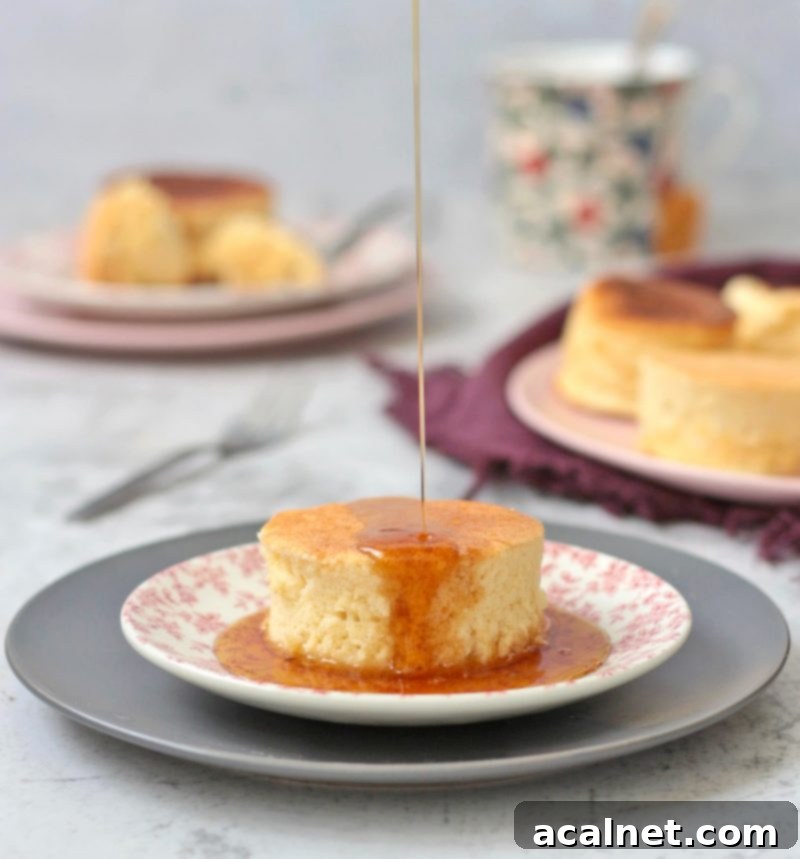
More Breakfast Ideas:
- Fluffy Blueberry Pancakes
- French Buckwheat Crepes
- Dutch Baby Pancakes
- Homemade Cinnamon Scrolls
- Banana Buckwheat Pancakes
- Easy Lemon Sweet Rolls
- 3-Ingredient Sugar-Free Banana Pancakes
- Savory Cheese Pancakes
- Traditional French Crêpes
- Creamy Banana Chia Pudding
Made this recipe?
Let us know if you liked it by leaving a comment below, and tag us on Instagram @a.baking.journey with a photo of your creation!
Recipe
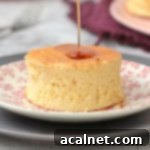
Fluffy Pancake Recipe (Japanese Soufflé Pancakes)
Servings:
8 Pancakes
Author:
Sylvie
15 minutes
30 minutes
45 minutes
Print Recipe
Prevent your screen from going dark
Equipment
- Round Pastry Rings (2 inches high by 2 and 2.5 inches wide)
- Non-Stick Skillet
Ingredients
- 2 Egg Yolks
- 2 Tbsp. Powdered Sugar
- 1/4 cup Whole Milk
- 1/2 cup All-Purpose Flour
- 1/2 tsp. Baking Powder
- 4 Egg Whites
- 1 pinch Salt
Instructions
- Separate the egg yolks and egg whites. Place the egg yolks in a large mixing bowl and the egg whites in the bowl of your mixer. Set aside the egg whites.
- Add the powdered sugar to the egg yolks and whisk until creamy. Stir in the whole milk, then the flour and baking powder.
- Start whipping the egg whites with the salt, starting on a medium speed and gradually increasing to high speed until you get stiff peaks.
- Place a non-stick skillet with a lid on your stove and turn on low heat (as low as possible).
- While the skillet is warming up, fold about 1/3 of the whipped egg whites into the rest of the pancake batter. When smooth, add the rest of the egg whites in two times. Try not to overwork the batter to avoid deflating the egg whites.
- Generously grease your pastry rings (see note 1 for sizes) and skillet with cooking oil (see note 2). Place the rings in the pan and fill about half of the rings with the pancake batter. They will rise while cooking so be careful not to overfill them.
- Directly place the lid back on the skillet and leave to cook for 4 minutes. Carefully remove the lid (there will be some steam), gently flip each pastry ring with a flat spatula then place the lid back on for another 3 minutes.
- If the Soufflé Pancakes do not come out easily of the pastry rings, run a small sharp knife around the edges of the ring.
- Repeat the process if required, making sure to re-grease the rings between each rounds.
- Serve directly, warm.
Would you like to save this recipe?
We’ll email this post to you, so you can come back to it later!
Notes
- The Pastry Rings I use for this recipe were these sizes:– 2.5 inches wide / 2 inches high– 3 inches wide / 2 inches high
- I have tried using both butter and cooking oil in a spray form. The pancakes came out much more easily when using the cooking oil spray than with butter, so this is what I recommend using.
- If you do not have pastry rings, you can make your own by saving your cans and using a can opener on both ends.
- Yes, you can make Japanese soufflé pancakes without using molds! To do this, you will need to cook them a bit differently:
- Use a spoon or cup, add some batter to the pan. We recommend not cooking more than two pancakes in the same pan. Cover with a lid and cook for 4 minutes on the lowest heat possible.
- Remove the lid and add another scoop of pancake batter to the top of each pancake. Cover again, and cook another 4 minutes.
- Any remaining batter should be carefully added to the top of the pancakes. Then, gently flip them. Cover and cook another 5 minutes or so until the pancakes are cooked through.
Nutrition (per serving)
